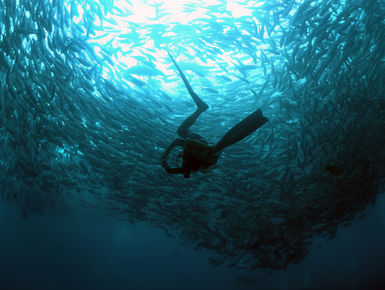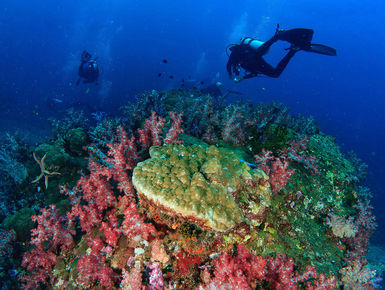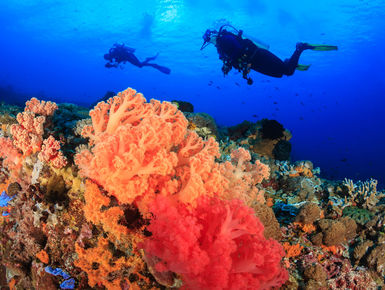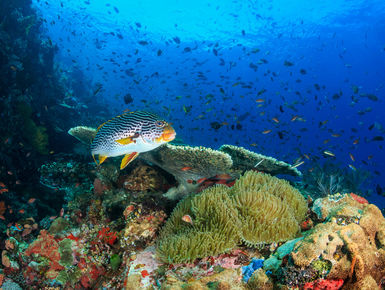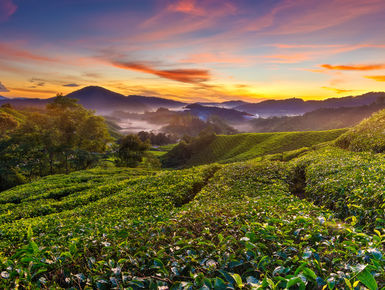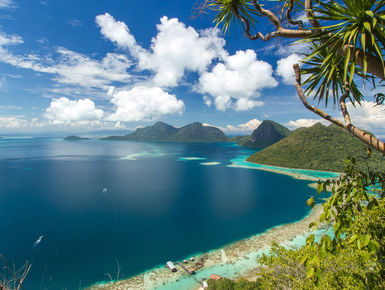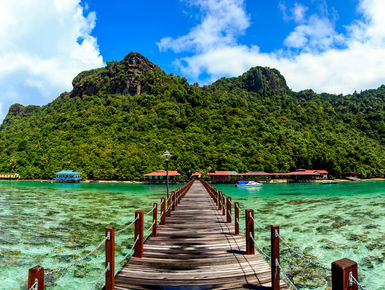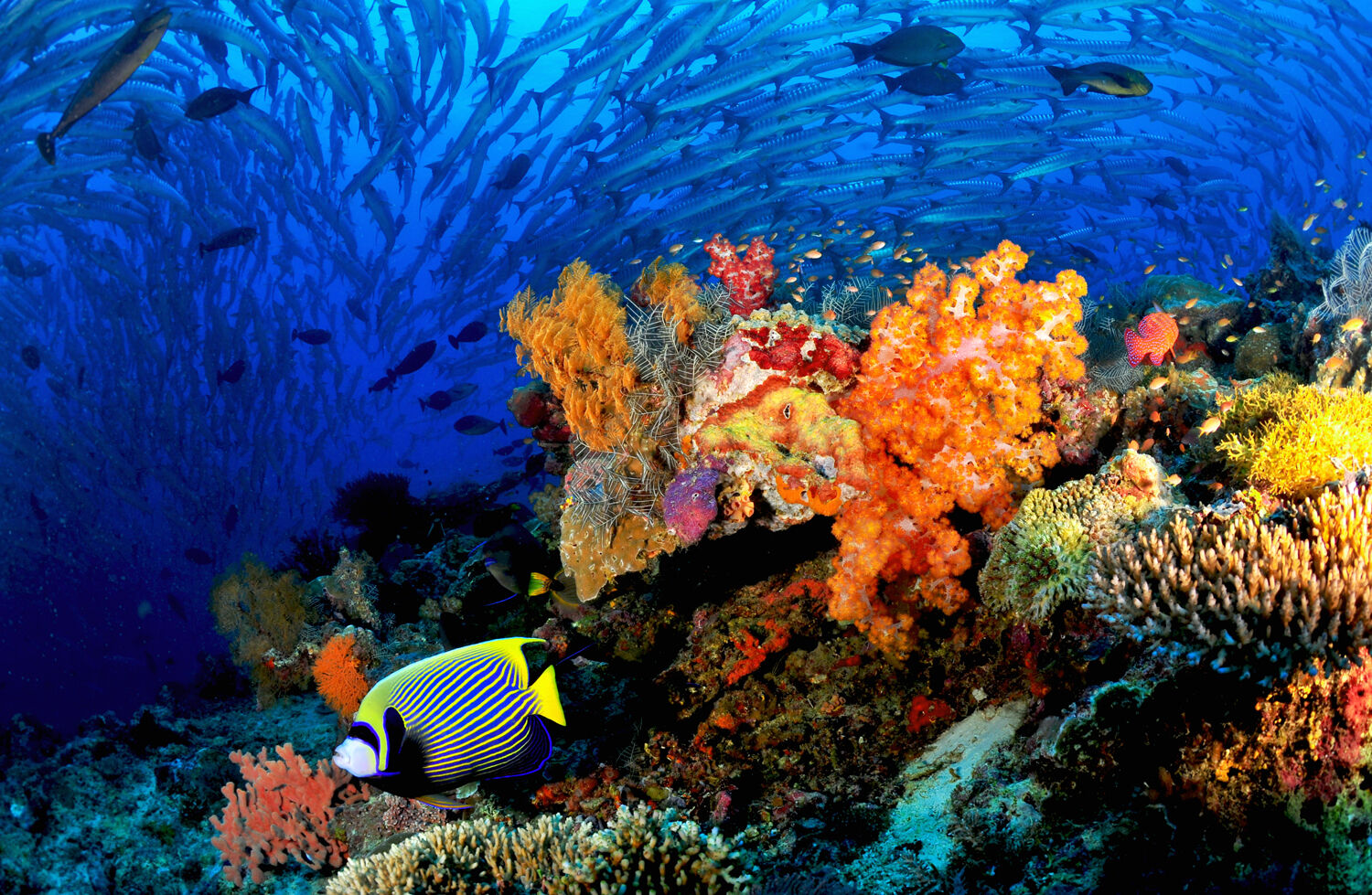
Big Thrills and Small Finds
Near the northeastern corner of Borneo, the small islands of Mabul and Kapalai are the gateway to spectacular diving. Top of the list is Sipadan Island Marine Reserve, where coral-covered walls rise 2,000 feet from the sea floor to attract vast numbers of green and hawksbill turtles, massive schools of barracuda and jacks, and a range of big pelagics from mantas and hammerheads to the occasional whale shark. Mabul is known for its muck diving and extensive invertebrate population and the unique water village of Kapalai holds resident mandarin fish. This pairing of large and small make Malaysia one of the most intriguing dive destinations in the world.
Highlights
- Best for: Casual to avid divers, and underwater photographers
- Best season to visit: Year round for Sipadan and muck diving sites at Mabul. Layang Layang's prime season runs from April to September
- Weather: A year round tropical climate with daytime temperatures into the 90s, dropping into the 70s at night in coastal areas. Offshore islands experience fewer heavy rains than on Borneo
Things to Do
- • Cultural Village Visits
- • Orangutang Sanctuary
- • Paddle Sports
- • Rainforest hikes
- • Wildlife tours of Kinabalu National Park
Malaysia Information
About Diving in Malaysia
Dive tourism in Malaysia centers around the state of Sabah on the northeastern edge of Borneo. Most famous is the small island of Sipadan, where steep walls rise from the deep water. A number of other islands in the area offer coral reefs, muck diving and big animal encounters. Coastal bays hold a rich diversity of macro life, while deeper waters hold swirling schools of trevally, pacific barracuda, hammerhead sharks to manta rays, and even the occasional whale shark. Kapalai and Mabul provide an abundance of weird and wonderful macro creatures, and Layang Layang atoll is one of the few places in the world where divers can witness schooling hammerheads. Water temperatures range from the high 70s to low 80s.
Diving in Malaysia Tips
Prepare for the steady currents that wash sites on Sipadan and Layang Layang by streamlining your dive gear and carrying a surface marker and compact deployment reel in case you become separated from the group. Pack a muck stick for shallow-water macro sites, and practice horizontal trim and no silt fin kicks.
Best Places to Dive in Malaysia
Sipadan for its walls, green sea turtles, schooling fish and sharks. Staghorn Crest reveals a mellower side of the island, with gardens of staghorn corals covering a gentle slope. Kapalai’s Mandarin Valley has an abundance of invertebrates in addition to the resident mandarin fish, and the sandy slopes of Mabul crawl with tiny finds like hairy squat lobsters and porcelain crabs. Hammerheads gather at Shark's Cave, and Layang Layang also offers relaxing fish watching at sites such as Wrasse Strip.
What to Pack for Diving in Malaysia
A skin suit to 3mm wetsuit. Surface marker and reel. Muck stick and compact light for muck diving. As with all tropical destinations in the region, check on advised vaccinations and a booster before travel.
Diving in Malaysia
On the northeastern corner of Borneo Island, the Malaysian state of Sabah juts eastward to meet the Sulu Sea. These waters are recognized as one of the most bio-diverse marine ecosystems in the world. Here divers will discover a range of underwater landscapes that are home to creatures both large and small. Sites include towering walls that rise from the open water to attract turtles, sharks and schooling pelagics; coral slopes and grottoes that harbor colorful collections of reef fish; and silt-laden shores that hide a menagerie of the small and unusual. Many consider the island of Sipadan to be the crown jewel of Malaysian diving. This tiny speck of green is surrounded by shallows that drop abruptly to depths of 2,000 feet. These undersea cliffs become gathering points for schools of bump head parrotfish, bigeye trevally and barracuda, which can shoal up in thousand-fish formations. Sipadan is also a gathering place for hawksbill and green sea turtles, and it's not uncommon to see a dozen or more on any given dive. Eagle rays and white tip sharks are seen on almost all sites, gray reefs congregate in deeper water, and there are chance sightings of mantas or a whale shark. Divers who take a closer look among the hard and soft corals that cover the walls will also discover an intriguing collection of smaller creatures. Currents can range from mild to exciting, and visibility can soar well past 100 feet. One of the more intriguing dive sites at Sipadan is Turtle Cave, where, at a depth of 60 feet, a tunnel leads into branching passages that go under the entire island. Most divers take a peak but don't venture into the dark labyrinth, which holds the skeletal remains of turtles who lost their way and then perished. Sipadan Island is now a protected marine park, with access limited to a maximum of 120 divers a day. Visits to the park begin at resorts on nearby Mabul and Kapalai islands, which are a 20 to 30-minute boat ride away. Pulau Mabul is a small sandy island with coconut trees and a local fishing village. Much more than a jumping off point for Sipadan, Mabul has earned a reputation as a muck diving mecca. Sandy and silty seabeds, coral outcrops, small walls and artificial reefs and jetties harbor a treasure trove of life. The broken landscapes are prime hunting grounds for cephalopods, including flamboyant cuttlefish, blue-ringed octopus, mimic octopus and bobtail squids. Mabul also overflows with crustaceans, from harlequin shrimp, mantis shrimp, and cleaner shrimp to hairy squat lobsters, spider crabs, porcelain crabs, and more. Keen-eyed divers will find giant, painted, and clown frogfish, along with other ambush predators such as leaf scorpion fish, dwarf lionfish, and crocodile fish. A survey of the bottom will reveal stonefish, stargazers, devil scorpionfish, and flying gurnards. Pipefish are common and tiny pygmy seahorses await discovery. Nearby at the over-water village of Kapalai, colorful mandarin fish perform intricate mating rituals among the pilings, mimic octopus, ghost pipefish and wasp fish lurk in nearby rubble fields. A short swim away, reef slope drops to open water, and a collection of small wrecks adds interest. Other prime diving areas around Sabah include the Tun Sakaran Marine Park, which is home to the nomadic Bajau Laut sea gypsies and offers year-round diving on coral-covered dropoffs, slopes and plateaus. Well to the north, the offshore atoll of Layang Layang is known for near-pristine reefs and seasonal aggregations of schooling hammerhead sharks. In addition to this big-ticket draw, the waters of the atoll offer wrecks, macro life and resident blacktip reef sharks, marble rays, bamboo sharks and leopard sharks. Also on the radar is scenic Lankayan island, which is gaining a reputation for the appearance of whales sharks from March to May.
Passport and/or Visa Requirements
U.S. Citizens need a valid passport for entry into Malaysia. The passport must be valid for 6 months beyond the date of entry into the country and must contain at least 1 blank page for entry stamp. No visa is required or stays less than 90 days.
Exit Requirements: There is an International Departure Tax which varies based on your departure terminal and destination. It should be included in your international airline ticket.
Immunizations
Although vaccines are not required for entry into Malaysia, you should check with your doctor and the Center for Disease Control for vaccinations currently recommended for travel to Malaysia at www.cdc.gov.
Culture and Customs
The country of Malaysia is divided by water, with Peninsular Malaysia to the west and East Malaysia occupying the upper portion of the island of Borneo. While the country's western regions are home to bustling modern cities such as Kuala Lumpur, eastern states are a less-settled land of mountains and rainforests, with coastlines ringed by spectacular beaches. This is especially true in eastern Saba, which is a realm of natural wonders. Towering treetop canopies are home to orangutans and comical pot-bellied proboscis monkeys. Pygmy elephants roam jungles and grasslands, while crocodiles lurk on the banks of the Kinabatangan River. A centerpiece of the region is Mount Kinabalu, the tallest peak in Malaysia at more than 13,000 feet. Mount Kinabalu and the surrounding upland are known worldwide for an unrivaled botanical and biological species biodiversity. Botanists have documented more than 6,000 plant species —a greater number than in all of Europe and North America combined. Modern times have come to the once-remote eastern corner of Malaysia, and you may spot a traditionally-dressed village elder conversing on a cell phone. But the old ways live on, and travelers are greeted with a smile and a salutation of “Selamat Datang,” which means “welcome.”
Electricity, Phone and Internet Access
Electric supply is on a 230-240V - 50 Hz system. An adapter will be needed for U.S. electronics. If your appliance is only rated for 110-120V input, you may also need a transformer converter to step down the voltage. The sockets use 3 flat pin plugs in a T-Shape.
The country code is 60. check with your cell phone provider to see what international plans are available to include text, data and voice. Many hotels offer WiFi.
Water Quality
Tap water in most Malaysian cities is generally considered safe to drink, but it is still advisable to boil water before drinking or to drink bottled water. Local bottled mineral water such as spritzer, come from a deep aquifer that has been studied for purity by hydrogeologists.
Language & Currency
The official language of Malaysia is Bahasa Melayu or Malay. English is required in schools and widely spoken in larger cities.
The local currency is the Malaysian Ringgit (MYR) and referred to with the symbol Rm and sometimes called the Malaysian Dollar. It is issued in denominations of 1, 5, 10, 20, 50 and 100 Ringgit notes. Coin denominations are 50, 20, 10, 5, and 1 sen (cents).
Most international credit cards – Visa, MasterCard, JCB, American Express and Diner Club are widely accepted in the cities. A small amount of money can be exchanged at the airport. Then it is best to head to a money changer or ATM to get the best exchange rate.
Time
Malaysia is on Malaysian Time (MYT) which is 8 hours ahead of Greenwich Mean Time (+8 GMT). Daylight Saving Time is not observed in Malaysia.
Location, Size and Population
Malaysia is located in Southeast Asia bordering Thailand, Indonesia and Brunei. It shares water boundaries with Singapore, Vietnam and the Philippines. The nation also includes Sabah and Sarawak on the island of Borneo to the east which they share with Indonesia.
Located off the southeast coast of Sabah there are three islands which attract divers from across the globe, these are Pulau Sipadan, Mabul and Kapalai. In 2004, the Government of Malaysia ordered all on-site dive and resort operators of Sipadan to move their structures out of the island by Dec 31, 2004. This move was mainly to conserve a balanced ecosystem for Sipadan and its surrounding reefs. Diving continues to be allowed in Sipadan for divers who are ferried in and out by dive and resort operators from the mainland and surrounding islands. Divers are required to purchase permits to dive Sipadan each day which allows a limited number of divers daily and is regulated by a lottery system.
A total of approx. 30 million people of which about 3.54 million reside in Sabah (2016).
